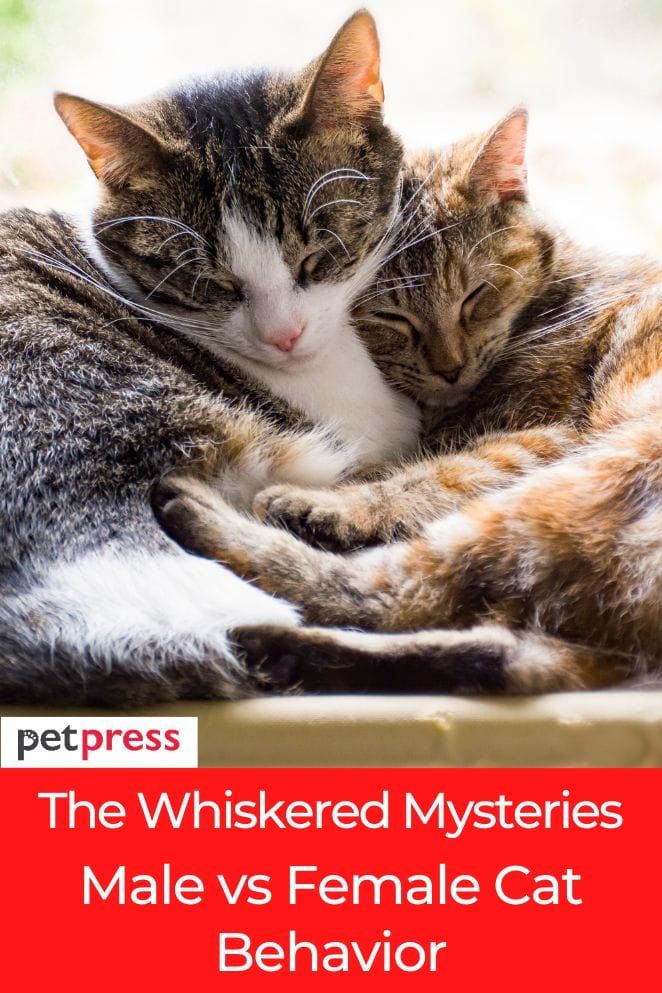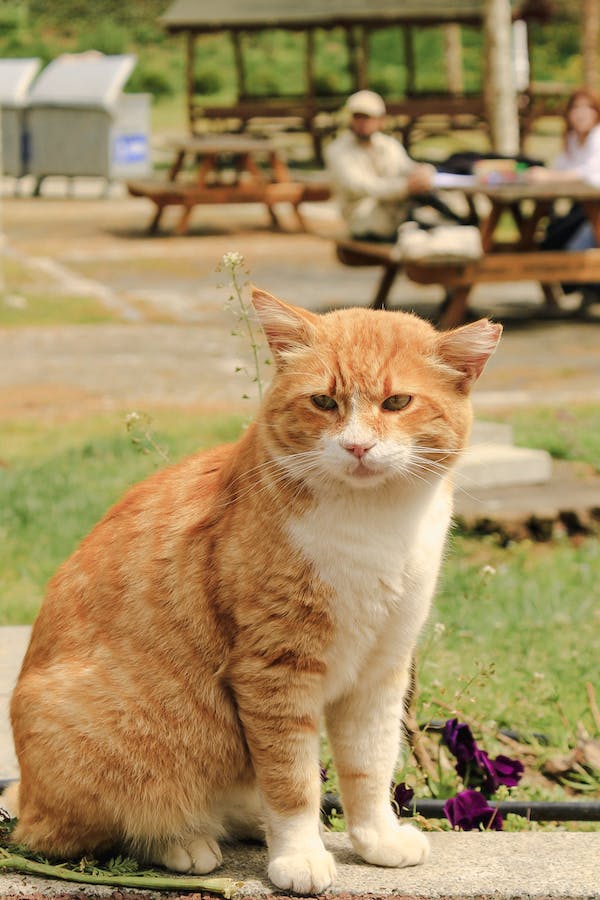
Greetings, fellow feline enthusiasts!
The realm of cats, encompassing both males and females, has consistently succeeded in capturing our affection due to their individualistic personas and charming peculiarities.
If you’ve ever contemplated whether your furry companion’s gender exerts an influence on their conduct, you’re certainly not alone.
In this forthcoming blog post, we’re immersing ourselves deeply into the intricate dynamics of male versus female cat behavior, to provide you with a clearer comprehension of the idiosyncrasies of your four-legged pals.
Common Behavioral Traits of Male Cats
Male cats, often referred to as the gentlemen of the cat world, do indeed exhibit several distinctive behavioral traits.
Let’s take a closer look at these characteristics in more detail.
Territorial nature
Male cats are known to be quite territorial by nature.
This behavior is deeply ingrained, even in domesticated felines.
They tend to stake out their territory and may become quite protective of it.
This territorial instinct is more pronounced in males than in their female counterparts.
To assert their dominance, they might engage in activities such as scent marking, which involves spraying urine around their chosen territory.
This marking serves as a clear “stay out” message to other cats.
Marking behavior
As mentioned, one common way male cats express their territoriality is through urine spraying.
This is particularly true if they haven’t been neutered.
Neutering can significantly reduce or even eliminate this behavior.
In addition to territorial marking, males may also mark their territory through scratching.
Scratching helps them not only leave a visual marker but also sharpen their claws.
Adventurous streak
Male cats often exhibit a more adventurous spirit compared to their female counterparts.
They are curious by nature and tend to explore their environment more actively.
You’ll find them prowling around, looking for new territories to conquer, both inside and outside the house.
This inclination for exploration can sometimes lead them to get into mischief or end up in unfamiliar places, so it’s essential to keep a close eye on them.
Playful and social
Male cats can be quite playful and social.
They often enjoy interactive games and toys that stimulate their minds and bodies.
Many form strong bonds with their human companions, seeking attention and affection.
While they might not be as independent as some female cats, this sociable nature makes them wonderful companions, often eager to curl up on your lap or follow you around the house.
Varied personalities
It’s important to note that every cat is an individual, and their personalities can vary widely.
While these traits are commonly observed in male cats, there are exceptions.
Some males may be less territorial, more laid-back, or less adventurous, and that’s perfectly normal.
Their behavior can also be influenced by factors like genetics, upbringing, and early socialization experiences.

Common Behavioral Traits of Female Cats
Female cats, the graceful ladies of the feline world, exhibit their own unique set of behavioral traits.
Let’s delve into the specifics of these characteristics to understand their nature more deeply.
Nurturing and protective
Female cats frequently receive praise for their nurturing instincts.
They possess a natural inclination for caregiving, not only towards their kittens but also towards their human companions.
This motherly instinct can extend to cuddling, grooming, and even keeping a watchful eye over you.
Some female cats even go above and beyond by adopting other kittens or non-feline pets, showcasing their strong maternal bonds.
Reserved demeanor
In general, female cats tend to be a bit more reserved compared to their male counterparts.
They might approach new people and situations with caution and take their time to warm up.
This reserved nature can make them appear more self-reliant, as they tend to be cautious explorers when navigating their surroundings.
They’ll carefully inspect new environments or changes in their territory to ensure everything is secure and sound.
Less territorial
In contrast to their male counterparts, female cats are typically less territorial.
They’re less likely to engage in behaviors such as urine spraying or aggressive territorial disputes with other cats.
This can make female cats more amenable to sharing their space with other pets, which is particularly beneficial if you’re considering introducing a new feline friend or other animals into your home.
Affectionate and playful
While they may be reserved, female cats can also be wonderfully affectionate and playful.
They often enjoy interacting with their human family, playing games, and engaging in cuddle sessions.
Their loving and gentle demeanor makes them great companions, particularly for households seeking a cat that offers both affection and a sense of independence.
Varied personalities
Just like male cats, each female cat is a unique individual with her own personality.
Some may be more reserved than others, while some may be exceptionally outgoing.
Their upbringing, genetics, and early socialization experiences can all play a role in shaping their behavior.

Behavioral Variations in Neutered/Spayed Cats
The decision to spay or neuter your cat is an important one that can indeed influence their behavior.
Let’s explore how this procedure can affect the behavior of both male and female cats.
Neutered males
When male cats are neutered, meaning their testicles are surgically removed, several behavioral changes are commonly observed:
- Reduced aggression: Neutered male cats tend to be less aggressive than their intact counterparts.
- Less likely to spray: Unneutered males are more likely to mark their territory by spraying urine, a behavior that can be quite challenging to manage.
- Lower roaming tendencies: Neutered males are also less likely to roam in search of a mate.
Spayed females
For female cats, spaying (removing the ovaries and uterus) can also bring about several important behavioral changes:
- No heat cycles: One of the most significant behavioral changes in spayed females is the elimination of heat cycles. Female cats in heat can be quite vocal, restless, and sometimes even aggressive.
- Reduced roaming: Spayed females are less likely to roam and seek a mate, just like neutered males.
- Lower chance of mammary tumors: Spaying also significantly reduces the risk of mammary tumors, which are more common in intact females.
Factors Influencing Behavior
Cats are indeed as unique as snowflakes, and their behavior is shaped by a complex interplay of factors.
Let’s delve into these influences that make each feline friend one of a kind.
- Breed and genetics: Cat breeds come with their own predispositions to certain behaviors. Inherited characteristics can impact a cat’s temperament, activity level, and even their susceptibility to certain health conditions.
- Early socialization: Early socialization, or the experiences a kitten has during its formative weeks, is crucial.
- Environment: The environment a cat grows up in, and currently resides in, plays a significant role in shaping their behavior.
- Health and age: A cat’s age and health status can affect their behavior as well. Kittens are typically more playful and active, while senior cats may be more sedentary and have different needs.
- Human interaction: Cats are highly responsive to the way they are treated by their human companions.
- Trauma and neglect: Cats that have experienced trauma or neglect can exhibit a range of behavioral issues.

Popular Misconceptions Regarding Male and Female Cat Behaviors
There are indeed several common misconceptions regarding the behavior of male and female cats.
It’s important to dispel these myths and recognize that each cat is a unique individual shaped by various factors beyond their gender.
Let’s explore some of these misconceptions in more detail:
Male cats are aloof
A prevailing stereotype portrays male cats as aloof and distant creatures, starkly contrasting with their perceived affectionate female counterparts.
However, in the labyrinth of feline emotions, the role of gender is less significant than one might think.
A cat’s affection quotient is primarily sculpted by its individual personality and early socialization experiences, transcending gender boundaries.
Some male cats wear their hearts on their furry sleeves, relishing cuddles and companionship just as ardently as any female cat.
Female cats are docile
The notion that all female cats are inherently docile and easygoing is yet another misconception that deserves debunking.
While female cats may not typically exhibit the same territorial behaviors as unneutered males, they possess their own unique brand of feistiness and assertiveness.
Their behavior is sculpted by their individual personalities, much like their male counterparts.
Neutering eliminates gender-based behaviors
It’s a mistake to believe that spaying or neutering completely erases gender-based behaviors in cats.
While these procedures can influence certain behaviors like territorial marking, aggression, or heat-related behaviors, individual personality traits, and environmental factors still play a significant role.
Neutered male cats, for example, can still be quite territorial, and spayed females may remain assertive.
Gender dictates playfulness
The notion that male cats are inherently more playful while their female counterparts are less inclined to frolic is another widespread misconception that deserves debunking.
Playfulness unfurls as a vast spectrum within the feline community, influenced by an array of factors such as age, health, and early socialization experiences.
Cats of both genders can exhibit high levels of playfulness and activity, much like their more easygoing counterparts.
Gender determines compatibility with other pets
Assuming that one gender of a cat is inherently more compatible with other pets is not accurate.
Compatibility depends on individual personalities and how well animals are introduced and socialized.
A male cat can get along famously with a female dog, and a female cat can be best friends with another male cat.

How to Best Care for Male and Female Cats
the care you provide for your male or female cat is crucial for their overall health and happiness.
Let’s explore in more detail how to best care for your feline companion:
Love and attention
Cats thrive on love and attention.
Spend quality time with your cat, offering affection, cuddles, and interactive play.
Cats form strong bonds with their human companions, and your attention is vital for their emotional well-being.
Proper nutrition
Feed your cat a balanced diet appropriate for their age, health, and activity level.
Ensure they have access to clean, fresh water at all times.
Consult with your veterinarian to choose the right type of food and feeding schedule.
Safe environment
Create a safe and enriching environment for your cat.
Remove hazards like toxic plants, chemicals, and small objects they might swallow.
Provide scratching posts to satisfy their natural urge to scratch and explore.
Ensure windows and balconies are secure to prevent accidents.
Regular vet check-ups
Routine veterinary check-ups are essential to monitor your cat’s health and catch any issues early.
Vaccinations, dental care, and preventive treatments for parasites are all part of responsible cat ownership.
Neutering or spaying is also a critical decision, as it can help prevent behavioral problems and unwanted pregnancies.
Mental stimulation
Cats are intelligent and curious creatures.
Provide mental stimulation through toys, puzzle feeders, and interactive play.
Cats love to hunt, so toys that mimic prey or laser pointers can be particularly engaging.
Playtime
Regular playtime is essential for a cat’s physical and mental health.
It helps them stay active, maintain a healthy weight, and prevent boredom.
Dedicate time each day for interactive play sessions, whether it’s chasing a feather toy or a game of hide and seek.
Grooming
Groom your cat regularly by brushing their coat to prevent matting and reduce shedding.
Long-haired breeds, in particular, benefit from frequent grooming to prevent hairballs and skin issues.
Litter box maintenance
Keep the litter box clean by scooping waste daily and changing the litter regularly. Place the box in a quiet, accessible location.
Cats are clean animals, and a clean litter box is crucial for their well-being.
Socialization
Socialize your cat early in life and continue to expose them to new people and experiences.
Positive socialization can help prevent fear and aggression.
Safe outdoor time
If you choose to allow your cat outside, ensure they are in a safe, enclosed area.
Some cat owners prefer leash training for supervised outdoor adventures.
Outdoor cats face more risks, including traffic and exposure to diseases.
Conclusion
In the grand debate of male vs. female cat behavior, there’s no clear winner.
Both genders have their unique traits and quirks that make them special.
The key is to celebrate these differences and appreciate your cat for who they are, regardless of their gender.
FAQs
Not necessarily. Neutered males are less likely to spray, and many females never spray at all.
Some female cats can be incredibly affectionate, just like male cats. It depends on the individual cat’s personality and upbringing.
Spaying or neutering is usually recommended to prevent overpopulation and certain behavioral issues. Consult with your vet for the best advice for your specific cat.
Positive reinforcement training and patience can help modify certain behaviors, but remember that some traits are inherent to the cat’s personality.
- Essential Oils Safe for Cats: What Every Pet Owner Needs to Know - May 23, 2025
- Herbal Supplements for Cats: A Natural Approach to Cat Wellness - May 21, 2025
- Signs of a Healthy Cat Coat: What Every Cat Owner Should Know - May 19, 2025


GIPHY App Key not set. Please check settings